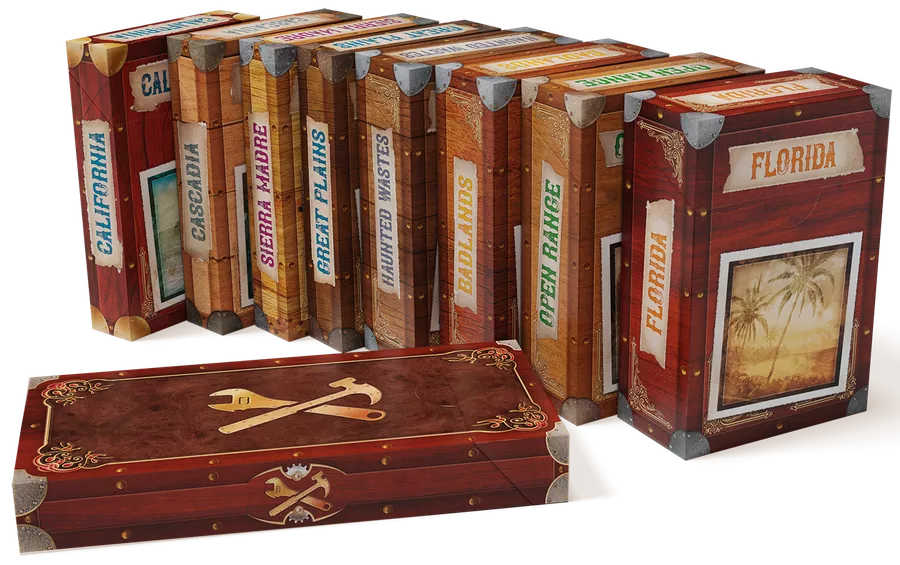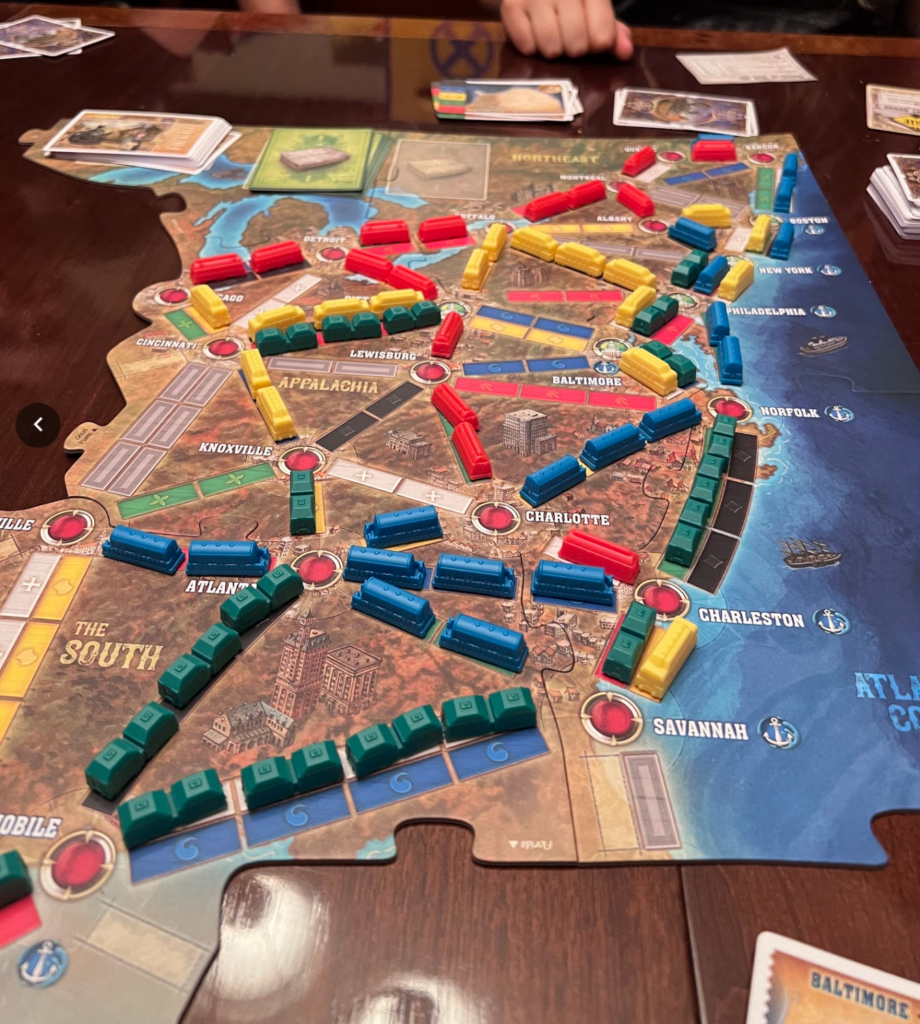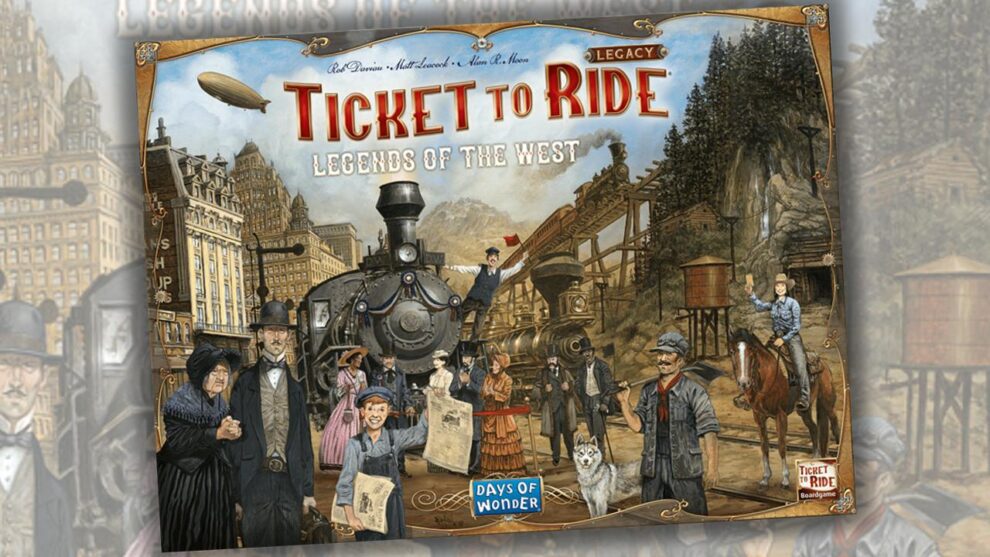Disclosure: Meeple Mountain received a free copy of this product in exchange for an honest, unbiased review. This review is not intended to be an endorsement.
All Aboard!
It’s the late 1800’s. Up to five fledgling railroad companies are all vying to be the first to complete routes across the country and scoop up valuable real estate. Throughout twelve sessions, the game map will slowly unfurl before you, revealing new mechanics, cities, and new tickets and routes to claim. Power will shift between individual sessions, with certain players claiming temporary power and decision-making based on performance, while last place gets a small boon for the next game to boost their odds.
I’ve played close to a dozen legacy-style games over the last decade or so, and my experiences have ranged from thrilling and immersive experiences to games that never really grabbed hold of my group and got permanently shelved after a few sessions. Designer Rob Daviau is the father of the modern legacy game, kickstarting the craze with Risk Legacy back in 2011, and his modus operandi seems to be taking modern classics and tossing a fresh coat of legacy paint on them. For the most part, it has been a successful formula.
But… Ticket to Ride? Legacy? The mixture just didn’t sit right in my head. I’m admittedly not the biggest fan of the base game (though I will play the Europe variant if given the opportunity), but the idea of mashing up such a simple premise with a legacy campaign got the better of my curiosity. I grabbed my go-to gaming partner, my husband, and approached two of my non-board gamer friends to embark on this cross-continental journey with me. The campaign had some mixed results for us, but to its credit, we finished the whole thing in just a matter of weeks, which is a testament to how much it grabbed us and didn’t let go.
Spoiler Free Overview
In the next section below, I will discuss some slightly spoilery details about some game mechanics. While I fully believe what I discuss will not spoil the game for you, I want first to provide readers with a sanitized, spoiler-free version.
If you’ve somehow managed not to play Ticket to Ride all these years, the mechanics are simple. Players take turns drawing color-coded train cards, playing train cards to place trains on the board, or drawing tickets that reward points for completing continuous train routes from one named city to another. When one player runs out of trains, it’s the end of the game. Each variant of the game adds a little spice. Ticket to Ride: Europe adds tunnels and ferries to make route claims more challenging, plus train stations to use opponents’ routes. Ticket to Ride: Nordic Countries limits the player count to 2-3 players and revamps mechanics to be more about aggressive play.

Ticket to Ride Legacy: Legends of the West continues this trend. It doesn’t mess with the core gameplay loop too much. You’re still drawing cards, playing trains, and completing tickets. As a nice touch, when you complete a ticket, you have to physically “punch” the ticket with a hole punch. It’s a minor thing, but there’s something so satisfying about picking up your completed cards and hearing that satisfying crunch as you punch them each one by one. (As a side note, I’m still finding tiny hole-punch-sized bits of paper around my house weeks later.) This ticket-punching mechanic is the game’s primary way of removing cards from the game to make sure you’re always seeing some new content when you play. After each session, you’ll stuff your scoresheet and some cards through a mail slot to go into your “vault,” where they’ll remain hidden until the final session. The rest of your cards go into your “office” to be broken out again at the start of the next session. While most of the components were amazing, the jigsaw-like game board pieces were totally warped and bent when we opened our copy. It took a few days of sitting underneath a pile of board games to flatten them out.
At the start of the campaign, you only have access to the East Coast and a handful of trains. After each session, whoever wins that session will choose which territory to expand to next. You’ll go to Florida, the Open Range, the Great Plains, and California, just to name a few. Most new territories also introduce new mechanics to the game, which I will explain more in the spoiler section below. These mechanics range from temporary one-or-two-session-long scoring opportunities to be tallied at the end of the campaign to permanent fixtures that must be considered in strategizing moving forward. Some of these are successful and fun! Some of them are… not! It’s a mixed bag.

This is all wrapped in a loose plot told through newspaper headlines and vague references. This is where the game struggled the most for me, as I just couldn’t force myself to care much about the dastardly Mama O’Connell and her bandit ways. She’s ever-present in the story cards, events, and game mechanics as a vague adversary, but reading those headlines to see what new thing she’s been doing ground the game to a halt. I honestly don’t think I needed some grand narrative about my simple train game; we all knew what we were signing up for here.
Here There Be Spoilers
While some mechanics are fun, like the circus, others introduce things that are either purely penal to the players that dissuade you from engaging with them or seem too random to accomplish. The gold rush mechanic, for example, involves flipping cards from the top of the deck and hoping you don’t hit certain ones with a skull icon. By our accounting, skulls comprised around a third of the train card deck, making that task seem impossible even with some luck-fixing available. Six total treasure hunts can be completed, and throughout our sessions with the mechanic, there was only one successful hunt compared to the ten attempts. Engaging with a mechanic with that low success rate just doesn’t seem like a good use of time.
The thematic flavor of each region varies from boring and historic to weird and wild. There’s a gold rush in the Badlands, which fits the historical vibe. Elsewhere, there’s a… haunted ghost train cursing people! Excuse me!? And just wait until you hear what’s happened to California! Most new regions are a joy to discover. Part of that joy is the radical shifts between normal and weird, but it left me wishing they had gotten even more bizarre with it. As I eyeball the frontier box labeled “Haunted Wastes,” knowing some spooky curse mechanic is waiting for me, it makes reading the dry plot with Mama O’Connell even duller than it already is. I was pleasantly surprised by how many science fiction and fantasy elements were allowed into the story to elevate the setting, but it made me wish for even more. Come for the trains; stay for the alien abductions! Come on, Days of Wonder – where are my train-robbing aliens?!
Joking aside, none of the mechanics had enough impact on the endgame. At our table, we had one player who dropped everything when a new scoring mechanic was introduced to maximize points as much as possible. Then there was me, who largely ignored the pop-up mechanics and focused on completing as many tickets as possible, which is usually the best strategy in base Ticket to Ride. At the end of our campaign, I scored a commanding victory when all things were tallied, despite mostly ignoring the tertiary mechanics. I am happy to have won the campaign, but even then, there was a twinkle in my eye, wishing I had been blindsided by how impactful those other mechanics were instead of the optimal strategy being “just play normal TTR and hope for the best.”
Final Destination
Though some of the mechanics were mixed and the campaign’s story was a big ol’ nothingburger, when we wrapped the twelfth and final session I couldn’t help but reflect on my time with Ticket to Ride Legacy: Legends of the West fondly. Is that because I won, mercilessly crushing my rivals who dared oppose me? Well, yes, possibly. But I also think it’s because it’s a concise, complete experience. Twelve games don’t take that long. In the early sessions, we were getting two or three games done in a single sitting because you start with so few trains and so little of the map unlocked. Games gradually take longer as the campaign stretches on and more of the map becomes available, but it’s never so long that it overstays its welcome.
You are left with a new version of Ticket to Ride by the end, meant to be replayable as a custom game board. This trick worked a lot better with other legacy games. Namely, the board Betrayal Legacy leaves behind is remarkable because the board is truly unique to your campaign, and all the items, omens, and events are influenced and named by your campaign’s participants. The same isn’t true for Legends of the West because, after the campaign, you need to reset a bunch of board elements and retired cards to make a functional, evergreen game. It robs the board of much of its personality and strips away some of the imprint your campaign made over twelve sessions.

Will I be popping out the post-campaign version of Ticket to Ride Legacy: Legends of the West soon? No, probably not. If the train mood strikes me, I’ll stick to my worn and tattered copy of Ticket to Ride: Europe. But for twelve sessions, I was enthralled by what sort of mechanics they’d introduce next to iterate on the formula. Sometimes, the reveals were joyous, and sometimes they fell flat. But on average, across twelve sessions, I was excited to rip open that next box or envelope and see what was inside. The story beats with Mama O’Connell didn’t work for me, but at the end of that twelfth session, ripping open my vault to excitedly rediscover all the forgotten cards and sessions from earlier in the campaign was an excellent experience. Everyone at the table enjoyed watching the contents spill out everywhere, and the final scoring was a nail-biter.
I recommend this game to families or groups of casual board gamers looking for an excellent excuse to buckle down and play one game repeatedly to get through the campaign. Those looking for strategic heft likely won’t find it here, and that’s perfectly fine. Other legacy games like Frosthaven and Gloomhaven can scratch that itch. For a long time, I’ve advocated that Ticket to Ride should be the gold-standard gateway game to introduce people to the hobby over things like Catan and Dominion. That holds true here with the idea of a legacy game. If you want to ease a group of casual gamers into their first legacy experience, you can’t go wrong with Ticket to Ride Legacy: Legends of the West. New mechanics come and go quickly and are easy to understand, and the long-term goal of “scoring the most points” stays the same throughout the process. Even minor permanent powers and passive bonuses remain easy to grasp throughout all twelve sessions. I asked a few of my non-hardcore gamer friends to embark on this legacy journey with me, and twelve sessions later, they stuck with it. For as many legacy games as I’ve quit playing halfway through, that alone is a testament to the quality on display here.












I have brought the game on my IPad and it worked great when I first played it but now it just keeps cutting me off.
It will not let me finish a game. Very disappointed.
Carol